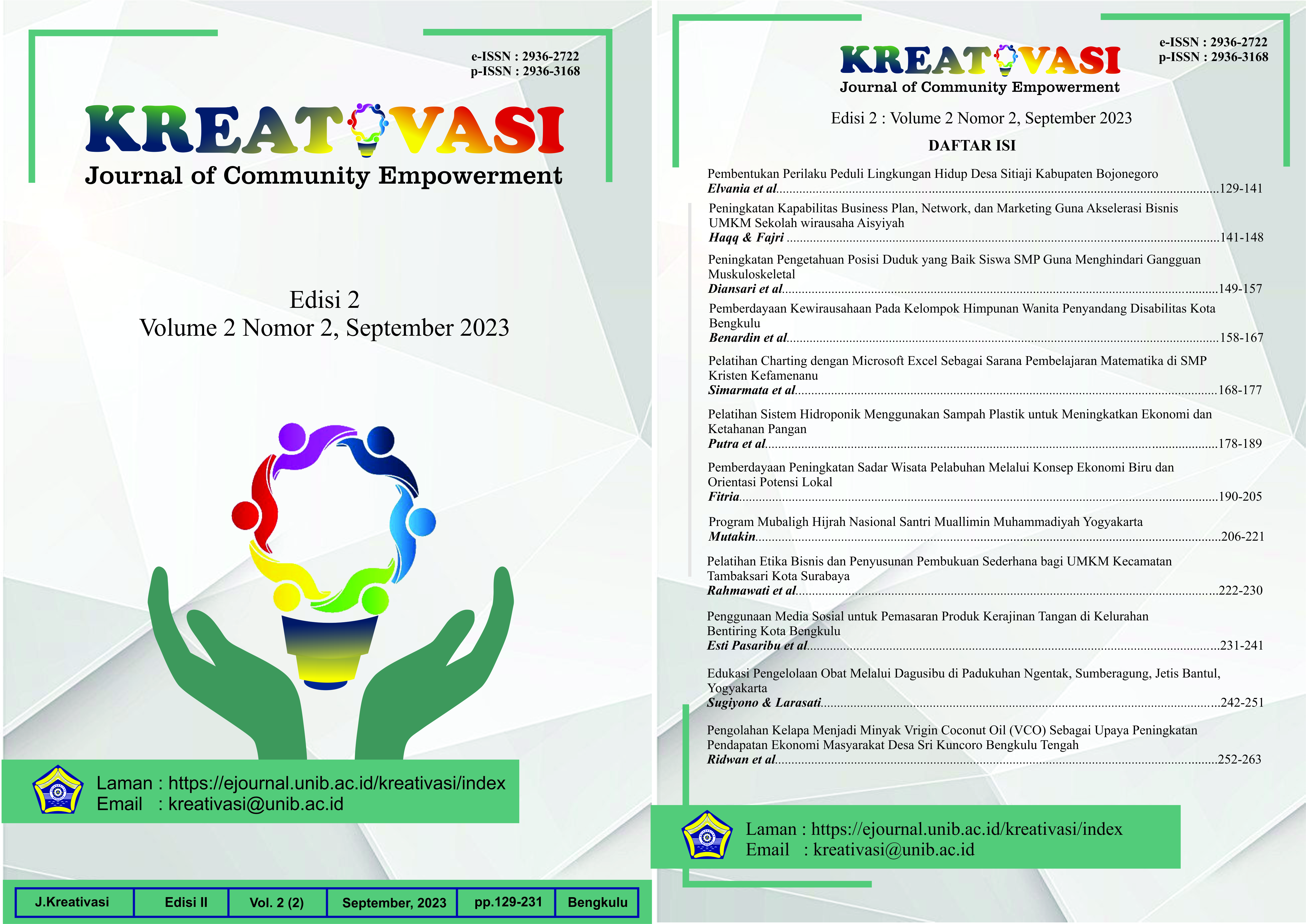Main Article Content
Abstract
Sitting position is a part of student’s activities. When students sit in wrong position in the long term that would cause back pain until musculoskeletal disorders. In industrial engineering studied about musculoskeletal disorders that can be seen by pain, stiffness, swelling, redness and changes in joint shape. This community service aims to provide knowledge about good sitting position for Junior High School of 10 Surakarta’s students to avoid musculoskeletal disorders. It is held by face to face. Started with socialization-consultation followed by demonstrations and examples good sitting recommendations. The results showed that all students understood and applied good sitting methods based on the criteria for a good sitting position with a score of more than 77% for each criterion. The details are all of them (100%) already know and apply sitting with an upright body position; 80% have implemented sitting with knees and hips parallel; 77% have implemented sitting with their feet flat on the floor; 90% have implemented sitting by setting a comfortable chair distance and 83% have implemented a reading distance of around 30 cm. It can be concluded that the principles of ergonomics are relevant for improving body posture and avoiding musculoskeletal disorders especially for students. So, it is expected that students consistently sit in a good position.
Article Details
Copyright (c) 2023 Brilian Nur Diansari, Fery Wisnu Saputro, Ikhsanur Rahmad, Muhammad Hidayah Tullah

This work is licensed under a Creative Commons Attribution-ShareAlike 4.0 International License.
- This statement is a commitment from the author, to respect copyright, both in terms of quoting the work of others, as well as in the use of journal content.
- If needed, the author can send a statement of authenticity of the manuscript. With the receipt of an article by the Editor of Kreativasi - Journal of Community Empowerment, the article submitted has the copyright held by Kreativasi - Journal of Community Empowerment:
- Kreativasi - Journal of Community Empowerment has the right to reproduce and distribute articles that have been published in journals.
- The author is not permitted to publish the same article that has been published in this journal.
References
-
Anies. (2005). Penyakit Akibat Kerja : PT. Elex Media Komputindo.
Fitrihana, N., & Rini, D. (2008). Perbaikan Area Kerja di Industri Garmen dengan Pendekatan Ergonomi Partisipatori dan Hubungannya dengan Produktivitas dan Kualitas : Universitas Gadjah Mada.
Hastuti, R.P., & Sugiharto. (2010). Hubungan Antara Sikap Kerja Duduk dengan Gejala Cumulative Trauma Disorders. KEMAS, Vol.6(1), p.8-15. https://doi.org/10.15294/kemas.v6i1.1746
Iskandar, M.M., Fairuz, Q., Patrick, W.G., & Susan, T. (2020). Penyuluhan Posisi Duduk yang Benar untuk Kesehatan Punggung Bagi Masyarakat Awam. MEDIC, Vol.3(2), p.121-125. https://doi.org/10.22437/medicaldedication.v3i2.12536
Muhaimin. (2002). Paradigma Pendidikan Islam Upaya Mengefektifkan Pendidikan Agama Islam di Sekolah : PT. Remaja Rosdakarya.
Novendy, Enny, I., & Silvana, T., (2020). Peningkatan Pengetahuan Posisi Kerja yang Baik Bagi Pekerja Pengguna Komputer Guna Menghindari Terjadinya Gangguan Muskuloskeletal : Universitas Tarumanegara.
Saputri, J., & Sutikno. (2021). Penyuluhan Posisi Duduk yang Benar Untuk Kesehatan Punggung pada Siswa/i SMPN 15 Banjarmasin. Jurnal Suaka Insan Mengabdi (JSIM), Vol.3(2), p.142-146. https://doi.org/10.51143/jsim.v3i2.314
Tarwaka, Basri, S.S.A., & Sudiajeng, L, (2004). Ergonomi untuk Keselamatan, Kesehatan Kerja, dan Produkivitas : UNIBA PRESS.
Undang-Undang Dasar Negara Republik Indonesia Tahun 1945
Undang-Undang Nomor 20 Tahun 2003 tentang Sisrem Pendidikan Nasional
References
Fitrihana, N., & Rini, D. (2008). Perbaikan Area Kerja di Industri Garmen dengan Pendekatan Ergonomi Partisipatori dan Hubungannya dengan Produktivitas dan Kualitas : Universitas Gadjah Mada.
Hastuti, R.P., & Sugiharto. (2010). Hubungan Antara Sikap Kerja Duduk dengan Gejala Cumulative Trauma Disorders. KEMAS, Vol.6(1), p.8-15. https://doi.org/10.15294/kemas.v6i1.1746
Iskandar, M.M., Fairuz, Q., Patrick, W.G., & Susan, T. (2020). Penyuluhan Posisi Duduk yang Benar untuk Kesehatan Punggung Bagi Masyarakat Awam. MEDIC, Vol.3(2), p.121-125. https://doi.org/10.22437/medicaldedication.v3i2.12536
Muhaimin. (2002). Paradigma Pendidikan Islam Upaya Mengefektifkan Pendidikan Agama Islam di Sekolah : PT. Remaja Rosdakarya.
Novendy, Enny, I., & Silvana, T., (2020). Peningkatan Pengetahuan Posisi Kerja yang Baik Bagi Pekerja Pengguna Komputer Guna Menghindari Terjadinya Gangguan Muskuloskeletal : Universitas Tarumanegara.
Saputri, J., & Sutikno. (2021). Penyuluhan Posisi Duduk yang Benar Untuk Kesehatan Punggung pada Siswa/i SMPN 15 Banjarmasin. Jurnal Suaka Insan Mengabdi (JSIM), Vol.3(2), p.142-146. https://doi.org/10.51143/jsim.v3i2.314
Tarwaka, Basri, S.S.A., & Sudiajeng, L, (2004). Ergonomi untuk Keselamatan, Kesehatan Kerja, dan Produkivitas : UNIBA PRESS.
Undang-Undang Dasar Negara Republik Indonesia Tahun 1945
Undang-Undang Nomor 20 Tahun 2003 tentang Sisrem Pendidikan Nasional
